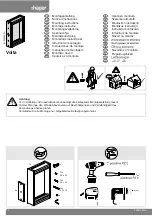
Siemens AG Österreich
5
of 8
SITOP power DC-UPS Module 15
English
!
WARNINGS
Only properly qualified personnel may work on or around this equipment.
The successful and safe operation of this equipment is dependent on proper handling, storage and installation. Correct functioning is
also dependent on the use of battery modules of type 6EP1935-6MD11, 6EP1935-6MD31, 6EP1935-6ME21or
6EP1935-6MF01.
The charging current level and the end-of-charge voltage must be adjusted with potentiometers R154 and R143 to the settings
recommended under "Technical Data". Setting incorrect current and voltage values reduces the life of the battery and may cause
irreparable battery damage.
CAUTION
Only trained personnel may open the unit. Electrostatically sensitive devices (ESD)
Description and Design
The DC-UPS module 15 is a chassis unit in the SITOP power product range for mounting on a DIN rail of type DIN EN 50022-35x15/7.5.
The modules must be installed in accordance with the applicable DIN/VDE specifications or pertinent regulations in the country of installation.
In conjunction with the battery module, it buffers a proportion of the load current (max. 15A) of 24V load current supplies with current ratings of 5A
and above in the SITOP power range.
Input "Input L+" on the DC-UPS module must be connected to output L+ of the 24V DC power supply unit and input "Input M" to output M of the
power supply unit. The battery module is connected to terBat and –Bat.
The loads to be buffered are supplied via outputs "Output L+" and
"Output M" on the DC-UPS module with the voltage connected to the input. If the 24V DC supply voltage fails or drops below the set cut-in threshold,
the battery module, which is maintained at full charge in continuous supply mode, is connected in to supply the loads.
The battery cut-in threshold, end-of-charge voltage and charging current can be set via three potentiometers. A switch block is provided for setting a
defined buffering (stored energy) time with subsequent disconnection of the battery (see Settings).
The operating states of the DC-UPS module 15 are signaled by three LEDs, two floating changeover contacts and an RS232 interface (6EP1931-
2EC11 only) (see Signaling).
Technical Data
Input quantities:
Rated input voltage: 24V DC
Operating voltage range: 22 to 27.5V DC
Max. input current at 24V and battery charging: 16.0A DC
Max. input current at 24V and charged battery: 15.1A DC
Max. battery current in floating operation: 15.1A DC
Power loss at 24V and battery charging: 14.0W
Power loss at 24V and charged battery: 12.5W
Power loss in floating operation: 12.5W
Output quantities:
Output DC voltage: V
A1
= 24V DC
Output direct current: I
A1
= 15A DC
Output characteristic of charging regulator:
The battery module is charged at an adjustable constant current until the
set end-of-charge voltage is reached.
End-of-charge voltage: v
A2
= 26.3 to 29.2V DC
Charging current: I
A2
= 0.3 to 0.7A DC
Settings
Setting the cut-in threshold:
If the input voltage drops below the selected cut-in threshold voltage, the UPS module switches over to floating operation. The loads are then supplied solely by the
battery module. The cut-in threshold is set with a screwdriver on potentiometer R222 (see page 2 for position).
Setting range: 18 to 26V DC (delivery state: 22.5V DC
±
0.1V)
Setting the charging current:
The battery module is charged at a constant current until the selected end-of-charge voltage is reached. The charging operation is then ended. When setting the
charging current, please read the instructions for the relevant battery module in order to select the optimum setting. The charging current is set with a screwdriver on
potentiometer R154 (see page 2 for position).
Setting range: 0.3 to 0.7A DC
±
0.1A (delivery state: 0.7A DC
±
0.1A)
Setting the end-of-charge voltage:
The end-of-charge voltage depends on the battery type and on the ambient operating temperature of the battery. Table 1 (see page 7) shows the end-of-charge
voltages for specific battery modules at different temperatures. It is possible to interpolate between these values. The voltage is set with a screwdriver on potentiomer
R143 (see page 2 for position).
Setting range: 26.3 to 29.2V DC (delivery state: 27.0V DC
±
0.1V)
Setting the operating state ON/OFF:
To prevent the battery from being discharged unintentionally (e.g. when the system power is disconnected), the DC-UPS module can be switched to operating states
"ON" and "OFF". In the "ON" state (wire jumper inserted between terminals X2.8 and X2.9), the DC-UPS module is fully functional according to specification. In the
"OFF" state (jumper open), the module does not switch over to floating operation when the mains supply is disconnected but remains functional in every other
respect. If the module is switched to "OFF" in floating operation, it ceases to operate in floating mode.
Setting the buffering time:
It is possible to select whether floating operation will be terminated after a prespecified period or when the exhaustive discharge threshold of the battery (= maximum
buffering time) is reached. The buffering time is set via switch block X400 (see page 2 for position) as illustrated in Table 2 (see page 7). Once the battery has been
disconnected, there is no way in which floating operation can be restarted again by altering the switch setting. Only when the input voltage has recovered can floating
operation be resumed.
The buffering time is a minimum of 4.5 minutes until discharge to 20.4V DC with a charged battery module type 6EP1935-6MD11 (3.2Ah) and a load current of10A.


























